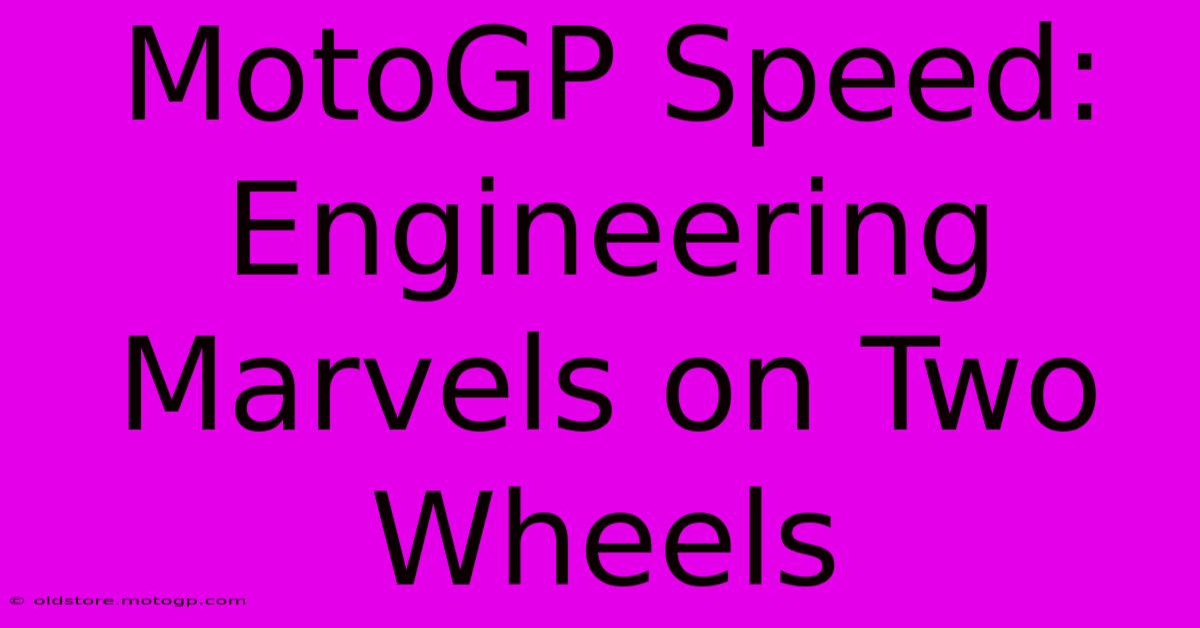MotoGP Speed: Engineering Marvels On Two Wheels

Table of Contents
MotoGP Speed: Engineering Marvels on Two Wheels
MotoGP. The name itself evokes images of blistering speed, heart-stopping overtakes, and the roar of finely-tuned engines. But behind the spectacle of these world championship races lies a fascinating world of cutting-edge engineering, pushing the boundaries of what's possible on two wheels. This article delves into the technological marvels that enable these incredible speeds.
The Heart of the Beast: The Engine
At the core of every MotoGP machine is a sophisticated engine, typically a 1000cc inline-four, though some manufacturers have experimented with V4 configurations. These aren't your average motorcycle engines; they're meticulously engineered powerhouses capable of producing over 260 horsepower and screaming to over 16,000 RPM.
Technological Advancements:
- Pneumatic Valves: Many MotoGP bikes utilize pneumatic valve actuation, allowing for incredibly high RPMs and precise control over valve timing. This technology ensures optimal engine breathing at all speeds.
- Seamless Shift Transmissions: Quick gear changes are crucial for maintaining speed and overtaking. Seamless shift transmissions eliminate the need for the clutch, allowing for incredibly fast and smooth gear changes.
- Sophisticated Electronics: Engine management systems are incredibly complex, controlling fuel injection, ignition timing, and traction control with millisecond precision. This level of control is essential for maximizing performance while maintaining stability.
Aerodynamics: Cutting Through the Air
Speed in MotoGP isn't just about engine power; it's also about minimizing aerodynamic drag. Teams spend countless hours in wind tunnels, refining the aerodynamics of their bikes to achieve optimal performance.
Key Aerodynamic Features:
- Winglets: These small wings generate downforce, keeping the front wheel firmly planted on the ground at high speeds, improving stability and enabling later braking.
- Fairings: The design of the fairings is critical for directing airflow around the bike, reducing drag and improving stability. Even small changes can significantly impact performance.
- Body Position: Riders adopt specific positions to minimize drag, often tucking their bodies close to the fuel tank.
Chassis and Suspension: The Perfect Balance
The chassis and suspension system are crucial for handling the immense power and speed of a MotoGP machine. These components work together to provide exceptional stability and responsiveness.
Technological Innovations:
- Carbon Fiber Frames: Lightweight yet incredibly strong, carbon fiber frames are vital for reducing the overall weight of the bike, improving handling and acceleration.
- Sophisticated Suspension Systems: These systems constantly adjust to changing track conditions, ensuring optimal grip and stability. Electronics play a crucial role in this adjustment.
- Optimized Geometry: The precise geometry of the chassis is carefully tuned to balance stability and agility. Even minor changes can significantly affect handling.
Tires: The Grip That Makes It Possible
MotoGP tires are far more than just rubber; they're highly specialized compounds designed to provide exceptional grip at extremely high speeds and under intense stress.
Tire Technology:
- Specialized Rubber Compounds: Each tire compound is carefully formulated to provide optimal grip depending on the track conditions and temperature.
- Tire Construction: The internal structure of the tires is crucial for providing stability and handling at high speeds.
- Tire Wear: Managing tire wear is a crucial aspect of strategy during a race, impacting the rider's performance.
The Rider: The Human Element
While the technology is impressive, the human element remains critical. MotoGP riders are highly skilled athletes with exceptional reflexes and precision. Their ability to push the machine to its limits, while maintaining control and managing risk, is a vital factor in achieving top speeds.
In Conclusion:
MotoGP speed is a testament to the incredible advancements in engineering and technology. The combination of powerful engines, sophisticated aerodynamics, precise chassis and suspension, high-performance tires, and the skill of the rider contributes to the breathtaking speeds witnessed in these exhilarating races. The pursuit of greater speed continues to drive innovation in the world of MotoGP, promising even more thrilling spectacles in the years to come.

Thank you for visiting our website wich cover about MotoGP Speed: Engineering Marvels On Two Wheels. We hope the information provided has been useful to you. Feel free to contact us if you have any questions or need further assistance. See you next time and dont miss to bookmark.
Featured Posts
-
A Day In The Life Of A Moto Gp Announcer
Feb 19, 2025
-
Cota Parking Easy In Easy Out With Your Pre Paid Pass
Feb 19, 2025
-
High Performance Engineering Moto Gp Bike For Sale
Feb 19, 2025
-
Moto Gps Greatest Moments Captured In Photos
Feb 19, 2025
-
Ride Like Your Heroes Moto Gp Replicas
Feb 19, 2025
